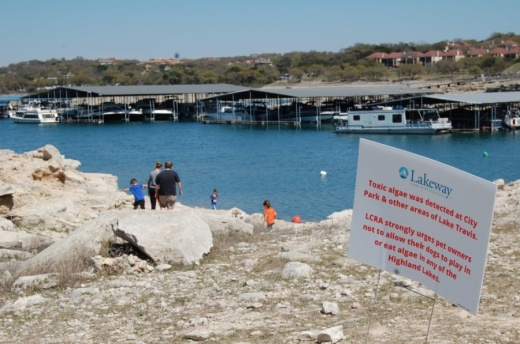Cyanobacteria—more commonly referred to as blue-green algae—continues to be present in Lake Travis, and the threat to dogs remains high, according to an April 6 news release from the Lower Colorado River Authority.
The bacteria, which strongly resembles aglae, can produce toxins known as cyanotoxins, which can be fatal to animals when ingested. The specific toxins found in Lake Travis are called dihydroanatoxin-a and anatoxin-a, the LCRA previously reported.
Dogs can be at heightened risk as they tend to play along the shorelines and drink lake water or lick their coats after swimming, the LCRA said.
The LCRA first detected cyanotoxins in the Hudson Bend region of Lake Travis on Feb. 26 following reports that several dogs became ill and one died after swimming in the lake. An additional nine locations along Lake Travis tested positive for the same toxins March 12.
Further tests taken March 23 also confirmed the presence of the harmful blue-green algae on boat ramps at Inks Lake and at Cottonwood Shores on Lake Marble Falls.
According to LCRA’s April 6 update, every test taken since late February has tested positive for cyanotoxins, and the LCRA is strongly urging pet owners to keep their dogs from playing in the Highland Lakes chain.
“Our ‘new normal’ is to treat all algae with caution,” said John Hofmann, LCRA executive vice president of water, in the release. “We know blue-green algae is present in the Highland Lakes, and it is not possible to tell by looking whether it is producing toxins.”
The most recent test samples were collected March 31 from the Hudson Bend region known as Travis Landing. While the algae source continues to test positive for cyanotoxins, samples from the surrounding water did not exhibit toxicity. The toxic blue-green aglae also remains in Lake Marble Falls and Inks Lake.
The Highland Lakes continue to open for recreation; however, those who choose to swim in the lake should take caution and avoid algae. The LCRA confirmed algae toxicity does pose a risk to humans if ingested.
Notably, dihydroanatoxin-a has also recently been detected within the city of Austin, according to an April 6 news release from the city’s watershed protection department.
The city confirmed low levels of the toxin were found in algae samples taken in mid-March from the Mansfield Damn area of Lake Austin. Trace levels were also found in Lake Bird Lake.
“If owners allow their dogs in the water, it is at their own risk,” the release states.
The department encouraged pet owners to rinse their dogs with clean water after swimming in local water bodies. Additionally, if a pet owner sees signs of excessive drooling, stumbling, foaming at the mouth or other signs of illness in their pet, they should seek veterinary care immediately.





